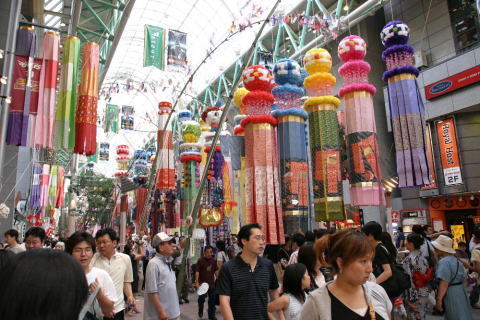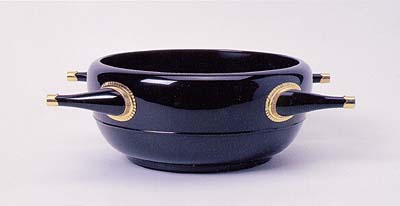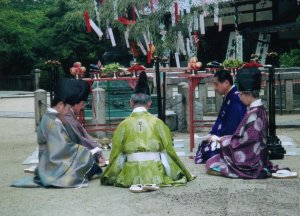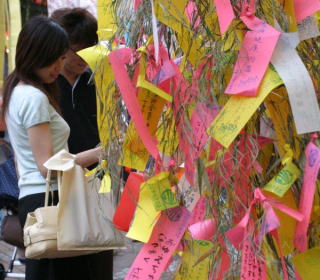 |
| photo by yoshik |
| TANABATA (Star Festival) |
 |
| photo by yoshik |
The Tanabata festival origined in China. It is based on a legend of two-star lovers: KENGYU <Cowherd>or HIKOBOSHI (Altair),
the god of agriculture, and SHOKUJO <Weaver Maid>or ORIHIME (Vega),
the goddess of
silkworm raising and weaving, are allowed to meet only once a year on July
7th.
Once upon a time, the emperor of the galaxy and his daughter Orihime lived
on the eastern side of the Milky Way.
Orihime loved her job and worked very hard everyday.
The emperor had been worried about her as she was a marriageable daughter
but she didn't have a boy friend.
One day, she fell deeply in love with Hikoboshi who lived on the western
side of the Milky Way.
He was brave and a hard worker, so the emperor allowed them to marry.
However, after she married she was so happy that she skipped her weaving..
Kengy also lazed.
They spent more time playing and less time working.
So, her father, the emperor of the galaxy, got angry and made them separate
far across the Milky Way.
They were so depressed, they threw themselves on the mercy of the emperor
of the galaxy,
but they were not allowed to live together any more.
However, the emperor of the galaxy couldn't stand to see her so sad and
weeping.
He permitted them to meet once a year, only on the night of July 7th.
On that day, magpies frame a bridge over the Milky Way for the couple.
....this is the story.....
This legend has many variations.
For example..Hikoboshi was an old man...
Orihime had two children and
she wanted to escape from Hikoboshi
etc.
.............................................................................................................................
Although Tanabata Festival was originally a Chinese festival, *KIKKOUTEN
Star Festival,
wishing for more knowledge and skills on arts, became mixed up with an
Japanese ancient tradition
that prays for good harvest. (*Kikkouten festival was introduced in Japan
in the Nara period)
Around July 7th of the lunar calendar is the season when rice flowers start
to bloom;
at the same time, it is a season of storms, flood damage, harmful insects,
and diseases on the rice.
In old time people believed that the almighty spirits transform into the
gods of the rice field,
so people offered foods from field and the sea and new fabrics to the gods
The fabrics were woven in a special cottage at the edge of the clean rivers or ponds by chosen maidens
The name of the loom with shelves used to make this fabric is Tanabata,
so this is the origin of the name of TANABATA.
The bamboo is decorated with five colored oblong paper
on which people write down their wishes.
Originally bamboo was put up as a point to receive descending gods.
Today paper is used instead of paper cloth.
Praying for good progress in needlework is not the only meaning of the
cloth.
The cloth also signify an offering to the gods.
In old times it was held as one of the annual events of the imperial court.
The Reizei Family ( whose ancestors are famous poets like Fujiwara-no-Teika
or
his father Fujiwara-no-Shunzei in 12th- 13th century) has been maintaning the
original way of the events which had been held among nobles in the Heian
period.
|
A Leaf of Kaji You can see a Kaji leaf floating on the water in a black basin called Tsunodarai in the picture. *** "Kaji" has the same pronounciation with a "helm" in Japanese, so this is for Hikoboshi. He uses it when he goes across the Amanogawa River (Milky Way). Nobles enjoyed the pictures of starlight reflected in the water. This makes impossible possible. Two stars might meet on the water surface.
|
|
||||||||||||
Offerings of Tanabata Decorated fruits, vegetables, fish, Japanese harp (koto), Japanese banjo(biwa), Five colored cloth, a basin of water with a leaf of kaji, etc for the two stars. *** |
Write and read "Waka" (classical Japanese poems) They write their "Waka" on a tanzaku (oblong cards) and offer them on the alter called Hoshinoza. They still keep this very traditional custom even today. |
|||||||||||||
| The Reizei Family offer a variety of products for the two stars. In the daytime, Reizei family members dedicate kemari (an ancient ball-kicking game) to the two stars In the evening, they dedicate Gagaku (traditional court music of Japan). After dark, they light candles in the garden, and start the Hiko-no-za, the offering of waka (Japanese traditional poetry). Then they start to making waka poetry one after the other agin and again till late at night, sitting face to face with a white cloth (which represents Milky Way or the Amanogawa river) between the male group and female group.. This ceremony represents the meeting of Orihime and Hikoboshi, when they can meet and spend a happy time only once a year. They wish they would be able to get a higher skills and ability. |
||||||||||||||
 |
| photo: courtesy of Saiku Historical Museum |
| Tsunodarai 角盥 (lit. horn basin) Wash basin which has four horn-shaped handles extending out horizontally to either side. The handles are for carrying by two people. Nobles washed their hands or face or hair in their room usuing tsunodarai. |
******
 |
||
|
********
 |
| Sasakazari笹飾り People write their wish on the oblong card (tanzaku) and put them on the bamboo twigs |
| From Ehon OguraNishiki by Okumura Masanobu | From YamatoKosakuesho by Ishikawa Tomonobu |
 |
| Hiroshige's |
The Tanabata Festivals held in Sendai (Miyagi Pref.), Hiratsuka (Kanagawa
Pref. ) and
Anjo (Aichi Pref. )/Ichinomiya(Aichi Pref.), are the 3 biggest Tanabata
Festivals of Japan.
| Date of traditional Tanabata | ||||||
| 2017 August 28 | 2022 August 4 | 2027 August 8 | 2032 August 12 | 2037 August 17 | 2042 August 22 | 2047 August 27 |
| 2018 August 17 | 2023 August 22 | 2028 August 26 | 2033 August 1 | 2038 August 7 | 2043 August 11 | 2048 August 16 |
| 2019 August 7 | 2024 August 10 | 2029 August 16 | 2034 August 20 | 2039 August 26 | 2044 July 31 | 2049 August 5 |
| 2020 August 25 | 2025 August 29 | 2030 August 5 | 2035 August 10 | 2040 August 14 | 2045 August 19 | 2050 August 23 |
| 2021 August14 | 2026 August 19 | 2031 August 24 | 2036 August 28 | 2041 August 3 | 2046 August 8 | - |